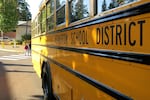
FILE - A Beaverton School District bus in this undated photo.
Rob Manning / OPB
Another large Oregon school district is at a standstill in ongoing union negotiations.
The Beaverton School District announced Thursday that it will be seeking the assistance of a state mediator in its negotiations with the Beaverton Education Association.
After Portland Public Schools and Salem-Keizer, Beaverton is the third largest school district in the state, enrolling roughly 38,000 students.
Around this time last year, Portland was gearing up for what would be a nearly monthlong teachers strike. Salem-Keizer narrowly avoided a strike in March after months of negotiations. Both districts used state mediators. The start of school a year ago was disrupted in Southwest Washington, with strikes and walkouts in Evergreen and Camas school districts.
Smaller districts across the region have faced stalled or combative negotiations between districts and unions. According to the Oregon Education Association, 49 local unions across the state currently have open contracts.
The Greater Albany Public Schools’ union, for example, held a rally in late September as they continue to bargain with the district over issues teachers in Beaverton are raising — student and educator safety, educator workload and compensation. According to OEA, the Greater Albany Education Association filed the paperwork Friday to declare an impasse. They are scheduled for all-day mediation this coming Tuesday.

Portland Association of Teachers hold a rally outside of the Portland Public Schools district office in Portland, Nov. 7, 2023, calling on the district to help bridge the gap at the bargaining table.
Kristyna Wentz-Graff / OPB
The Beaverton School District and BEA — which represents licensed staff, such as teachers, counselors, nurses, social workers, school psychologists and speech-language pathologists — have been in contract negotiations since mid-February.
According to Shellie Bailey-Shah, the district’s public communications officer, the bargaining teams are negotiating an updated contract while teachers and other licensed staff technically continue to work under the terms of the existing 2021-24 contract. The union has said they are working without a contract since the terms of the latest contract ended June 30.
Compensation and benefits are key sticking points, but the main focus of the union has been on poor working conditions, some of which they argue have led to students suffering in the classroom. Among those issues, echoed in complaints from other districts like Portland, is classroom temperatures.
Despite district claims that Beaverton classrooms are climate-controlled and protected from extreme weather events, union officials in September said Oregon’s summer heatwaves demonstrated how much work still needs to be done to keep students and educators safe.
“Students in middle school now have 88-minute P.E. classes, and they came back from those classes really hot and agitated,” said Lexie, a middle school educator, in a news release last month. The union did not provide the teacher’s last name. “I’ve also noticed that the hot classroom temperatures impact my neurodiverse students most acutely, as they are already working hard on self-regulation and [communicating their] needs.”

Students in class at Cedar Park Middle School in Beaverton, February 22, 2023.
Kristyna Wentz-Graff / OPB
District officials said Beaverton values its educators and is committed to securing an equitable contract that reflects their vital roles. They said the district has bargained in good faith and has presented a fair and competitive compensation package that would keep Beaverton teacher salaries among the highest in Oregon.
“Unfortunately, progress at the bargaining table has stalled,” district officials wrote in the announcement that went out to families Thursday evening, calling for state mediation. “The teams have not reached tentative agreements on any parts of the contract since May 2. After more than 150 days, 58 hours and 13 sessions of bargaining, BEA and BSD remain far apart on key issues.”
The district said BEA has made no movement toward agreement on compensation since May, re-presenting the same salary proposal of a 9% increase three times this year and 7% next year. Since June, they said, the union has reduced its insurance increase proposal by “just $7 per month.”
“More recently, the union reversed progress, bringing back costly proposals it had previously dropped,” the district added. “Currently, the district’s and union’s proposals are more than $229 million apart.”
Union members held a “walk-in” solidarity action on Monday at select school sites across the district to highlight the lack of protection for student learning environments in their contract. The union estimates more than 1,000 members participated. They were joined by senior leaders from the National Education Association and called for more systemic change in the legislature as part of the solution.
“The future of Oregon’s public school is in our hands, and we won’t stop fighting until every school building has the resources it needs to meet the social and emotional needs of all our students and their families,” Katie Lukins, vice president of the Beaverton teachers union, said in a statement about the walk-ins.
“For us, this fight is two-fold,” Lukins said. “We are fighting … for a fair and equitable collective bargaining agreement that funds our schools, and we want to see full funding from our leaders in Salem and Washington, D.C.”
The lion’s share of funding for public school operations comes from the state through a budget approved by the Oregon Legislature. In responding to recently announced school test scores, Gov. Tina Kotek has said she wants to increase K-12 funding while improving accountability measures to ensure funds are spent wisely.
Beaverton school administrators said they’re requesting assistance from a state mediator to help move the process forward and reach a “fair and sustainable agreement.”
“We understand that as long as negotiations are prolonged,” officials told the community, “licensed staff continue to go without cost-of-living salary increases and continue to pay a greater portion of their health insurance premiums.
“BSD is committed to achieving a resolution that supports educators, provides long-term sustainability for our schools and keeps our students at the forefront of every decision,” they said.
Union leaders argue using a state mediator will exclude some BEA educators from participating in what was otherwise an open bargaining process.
Lindsay Ray, president of the association, said they will continue to work toward a settlement regardless.
“We hope that BSD’s call for mediation signals they are finally ready to get serious about reaching a deal,” she said, pushing the district to prioritize “coming prepared for our meetings and engaging in meaningful negotiations.”
More details of each side’s proposed contracts and how they differ can be found on the Beaverton district website or BEA’s bargaining page.
